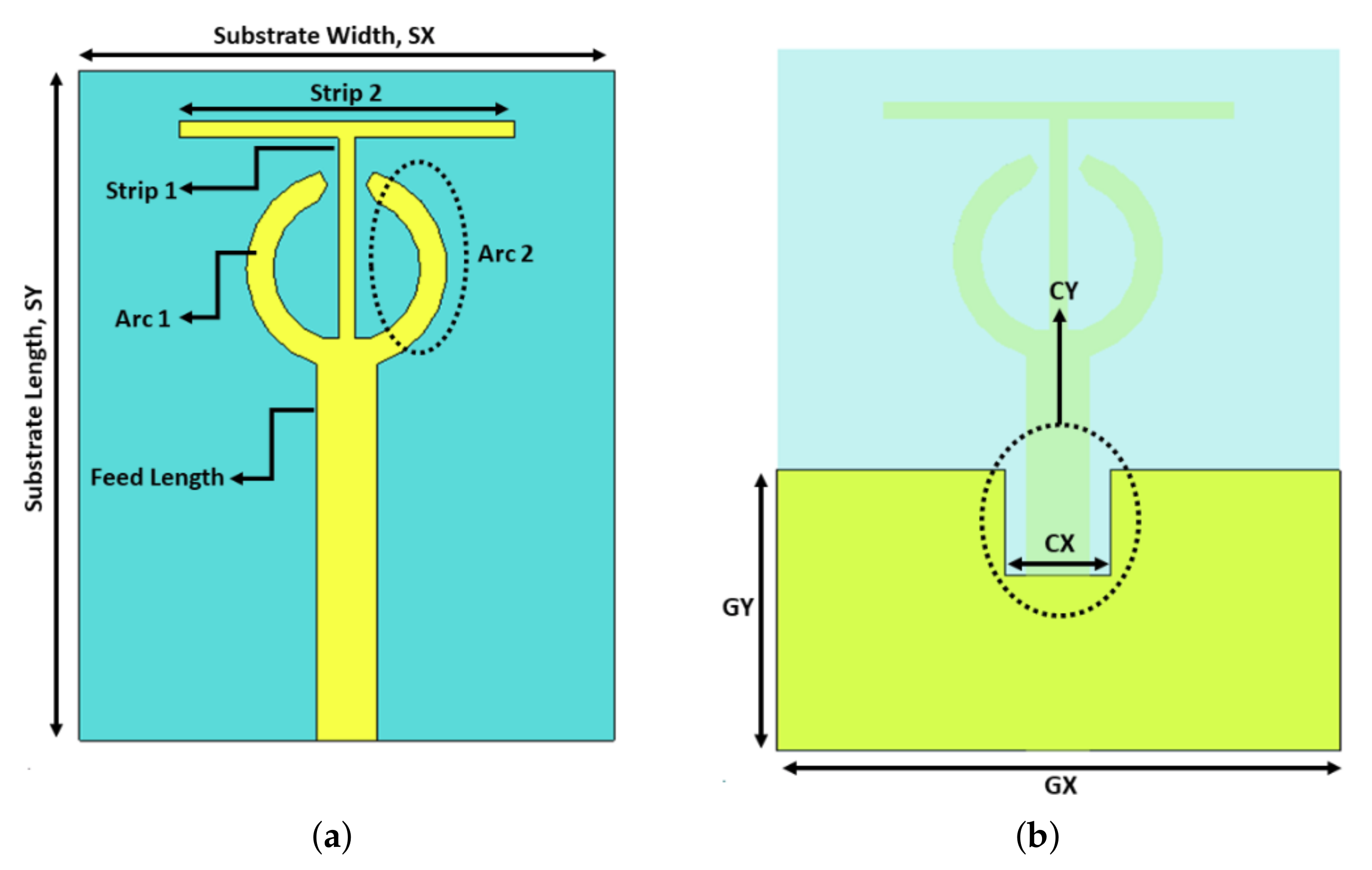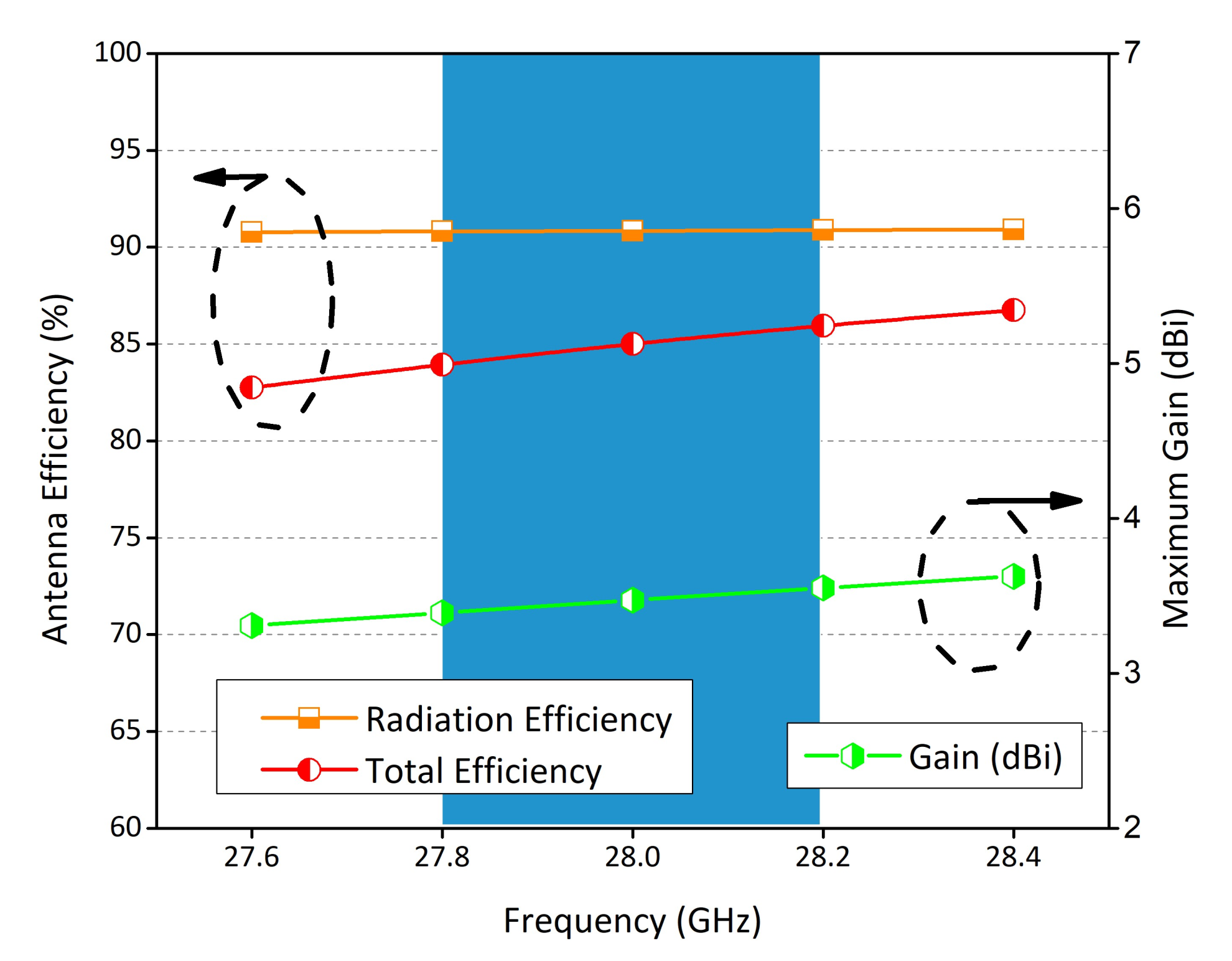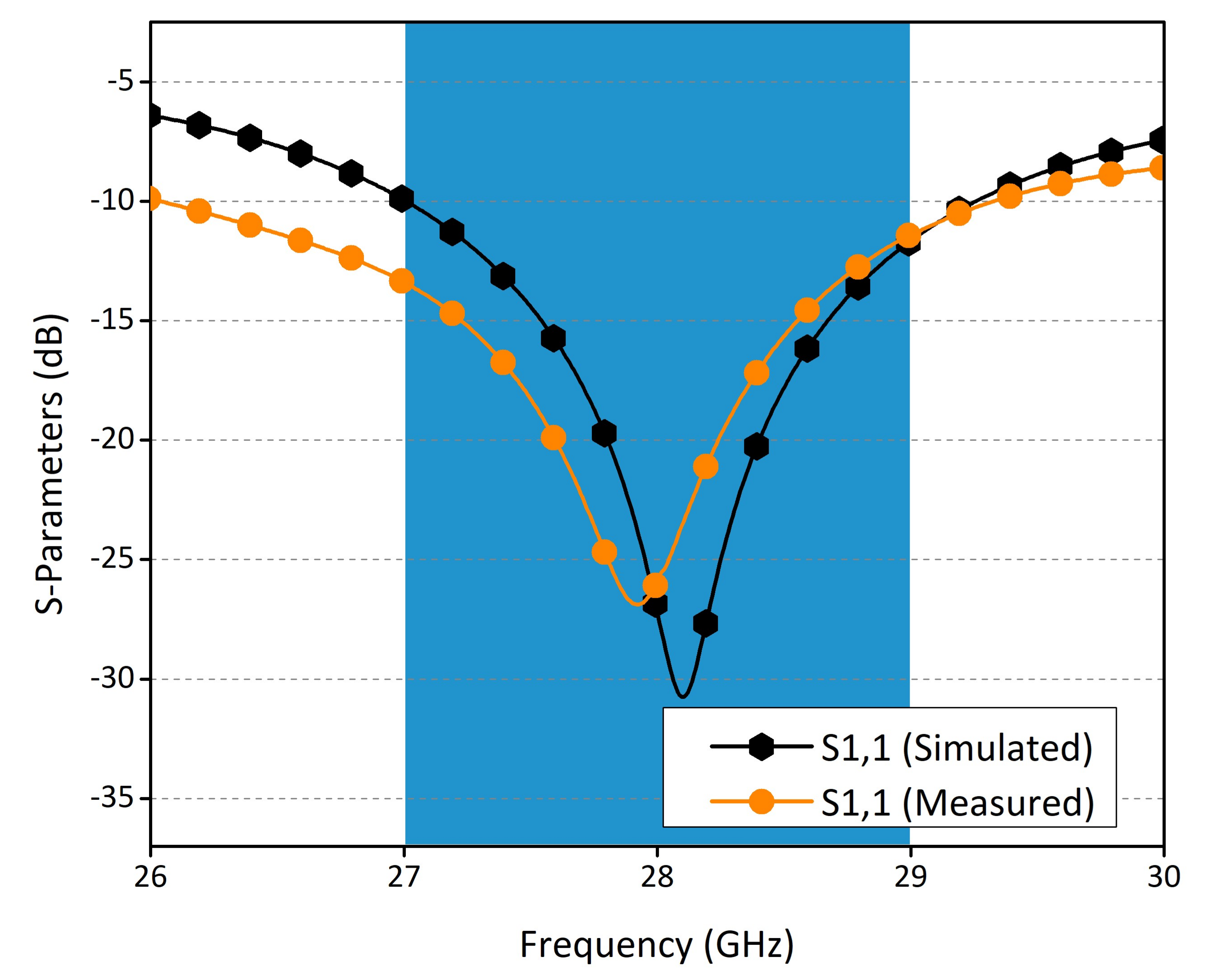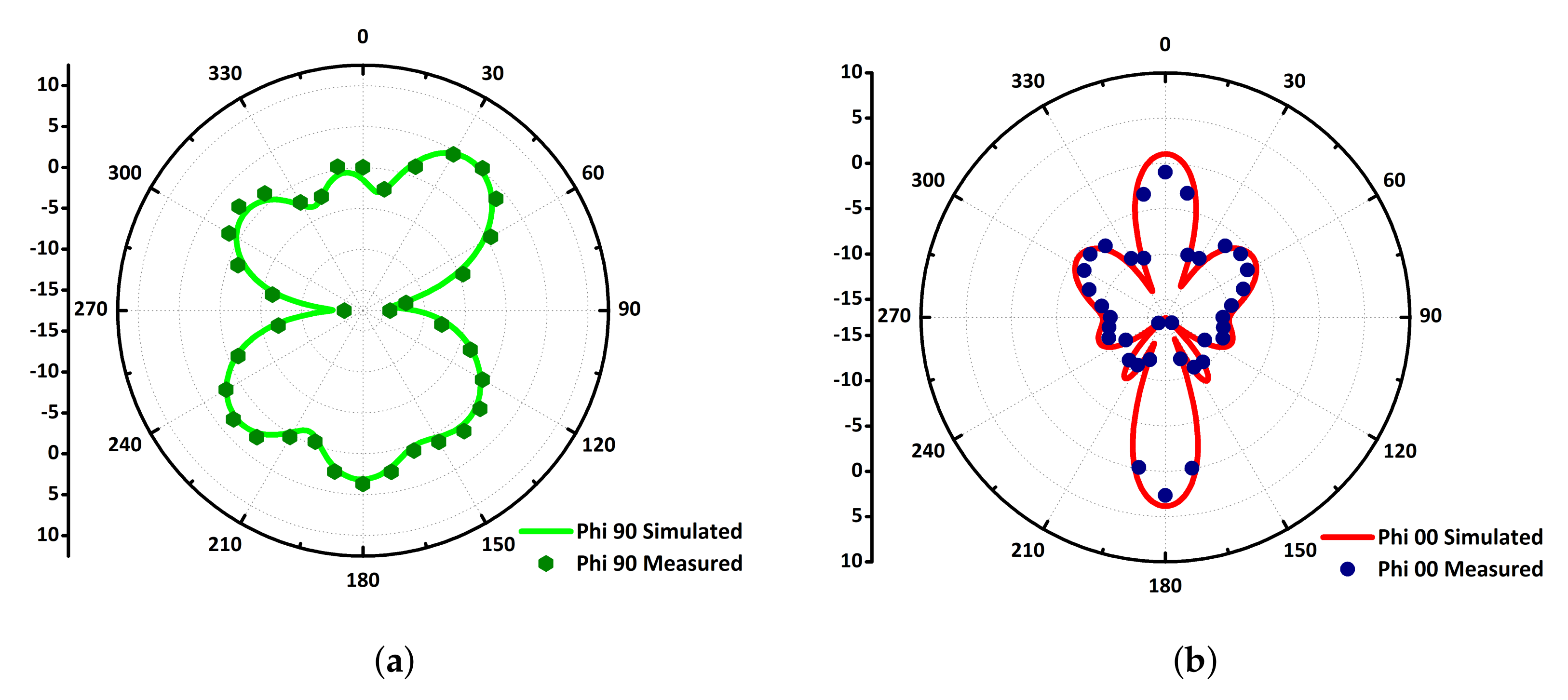A Novel Hook-Shaped Antenna Operating at 28 GHz for Future 5G mmwave Applications
Abstract
1. Introduction
2. Antenna Design
3. Array Transformation
4. Fabrication and Measurements
5. Conclusions
Author Contributions
Funding
Data Availability Statement
Conflicts of Interest
References
- Zhang, J.; Yu, X.; Letaief, K.B. Hybrid beamforming for 5 G and beyond millimeter-wave systems: A holistic view. IEEE Open J. Commun. Soc. 2019, 1, 77–91. [Google Scholar] [CrossRef]
- Kiani, S.H.; Altaf, A.; Abdullah, M.; Muhammad, F.; Shoaib, N.; Anjum, M.R.; Damaševičius, R.; Blažauskas, T. Eight Element Side Edged Framed MIMO Antenna Array for Future 5 G Smart Phones. Micromachines 2020, 11, 956. [Google Scholar] [CrossRef] [PubMed]
- Przesmycki, R.; Bugaj, M.; Nowosielski, L. Broadband Microstrip Antenna for 5 G Wireless Systems Operating at 28 GHz. Electronics 2021, 10, 1. [Google Scholar] [CrossRef]
- Hilt, A. Availability and Fade Margin Calculations for 5 G Microwave and Millimeter-Wave Anyhaul Links. Appl. Sci. 2019, 9, 5240. [Google Scholar] [CrossRef]
- Khan, J.; Sehrai, D.A.; Khan, M.A.; Khan, H.A.; Ahmad, S.; Ali, A.; Arif, A.; Memon, A.A.; Khan, S. Design and performance comparison of rotated Y-shaped antenna using different metamaterial surfaces for 5 G mobile devices. CMC Comput. Mater. Contin 2019, 60, 409–420. [Google Scholar] [CrossRef]
- Zhekov, S.S.; Zhao, K.; Franek, O.; Zhang, S. Test Reduction for Power Density Emitted by Handset mmWave Antenna Arrays. IEEE Access 2021, 9, 23127–23138. [Google Scholar] [CrossRef]
- Yang, Q.; Gao, S.; Luo, Q.; Wen, L.; Ban, Y.L.; Ren, X.; Wu, J.; Yang, X.; Liu, Y. Millimeter-wave dual-polarized differentially fed 2-D multibeam patch antenna array. IEEE Trans. Antennas Propag. 2020, 68, 7007–7016. [Google Scholar] [CrossRef]
- Rahman, S.; Ren, X.C.; Altaf, A.; Irfan, M.; Abdullah, M.; Muhammad, F.; Anjum, M.R.; Mursal, S.N.F.; AlKahtani, F.S. Nature inspired MIMO antenna system for future mmWave technologies. Micromachines 2020, 11, 1083. [Google Scholar] [CrossRef]
- Kamal, M.M.; Yang, S.; Ren, X.C.; Altaf, A.; Kiani, S.H.; Anjum, M.R.; Iqbal, A.; Asif, M.; Saeed, S.I. Infinity Shell Shaped MIMO Antenna Array for mm-Wave 5 G Applications. Electronics 2021, 10, 165. [Google Scholar] [CrossRef]
- Park, S.J.; Shin, D.H.; Park, S.O. Low side-lobe substrate-integrated-waveguide antenna array using broadband unequal feeding network for millimeter-wave handset device. IEEE Trans. Antennas Propag. 2015, 64, 923–932. [Google Scholar] [CrossRef]
- Zhu, Q.; Ng, K.B.; Chan, C.H.; Luk, K.M. Substrate-integrated-waveguide-fed array antenna covering 57–71 GHz band for 5 G applications. IEEE Trans. Antennas Propag. 2017, 65, 6298–6306. [Google Scholar] [CrossRef]
- Ullah, H.; Tahir, F.A. A broadband wire hexagon antenna array for future 5 G communications in 28 GHz band. Microw. Opt. Technol. Lett. 2019, 61, 696–701. [Google Scholar] [CrossRef]
- Ullah, H.; Tahir, F.A. A Novel Snowflake Fractal Antenna for Dual-Beam Applications in 28 GHz Band. IEEE Access 2020, 8, 19873–19879. [Google Scholar] [CrossRef]
- Zhang, J.; Ge, X.; Li, Q.; Guizani, M.; Zhang, Y. 5 G millimeter-wave antenna array: Design and challenges. IEEE Wirel. Commun. 2016, 24, 106–112. [Google Scholar] [CrossRef]
- Yang, B.; Yu, Z.; Dong, Y.; Zhou, J.; Hong, W. Compact tapered slot antenna array for 5 G millimeter-wave massive MIMO systems. IEEE Trans. Antennas Propag. 2017, 65, 6721–6727. [Google Scholar] [CrossRef]
- Shoaib, N.; Shoaib, S.; Khattak, R.Y.; Shoaib, I.; Chen, X.; Perwaiz, A. MIMO antennas for smart 5 G devices. IEEE Access 2018, 6, 77014–77021. [Google Scholar] [CrossRef]
- Jilani, S.F.; Alomainy, A. Millimetre-wave T-shaped antenna with defected ground structures for 5 G wireless networks. In Proceedings of the 2016 Loughborough Antennas & Propagation Conference (LAPC), Loughborough, UK, 14–15 November 2016; pp. 1–3. [Google Scholar]
- Ullah, H.; Tahir, F.A. A high gain and wideband narrow-beam antenna for 5 G millimeter-wave applications. IEEE Access 2020, 8, 29430–29434. [Google Scholar] [CrossRef]
- Khalily, M.; Tafazolli, R.; Rahman, T.; Kamarudin, M. Design of phased arrays of series-fed patch antennas with reduced number of the controllers for 28-GHz mm-wave applications. IEEE Antennas Wirel. Propag. Lett. 2015, 15, 1305–1308. [Google Scholar] [CrossRef]
- Khan, J.; Sehrai, D.A.; Ali, U. Design of dual band 5 G antenna array with SAR analysis for future mobile handsets. J. Electr. Eng. Technol. 2019, 14, 809–816. [Google Scholar] [CrossRef]
- Sehrai, D.A.; Abdullah, M.; Altaf, A.; Kiani, S.H.; Muhammad, F.; Tufail, M.; Irfan, M.; Glowacz, A.; Rahman, S. A novel high gain wideband MIMO antenna for 5 G millimeter wave applications. Electronics 2020, 9, 1031. [Google Scholar] [CrossRef]









| Parameter | Value in mm | Parameter | Value in mm |
|---|---|---|---|
| SX | 8 | SY | 10 |
| GX | 8 | GY | 4 |
| CX | 1.5 | CY | 1.5 |
| Strip 1 | 3.25 | Strip 2 | 5 |
| Arc 1 | 2.92 | Feed Length | 6 |
| Ref | Bandwidth (GHz) | Size L × W (mm) | Antenna Elements | Configuration | Gain (dBi) | Efficiency (%) |
|---|---|---|---|---|---|---|
| Rahman et al. [8] | 2 | 30 × 30 | 2 × 2 | Planar | 5.5 | 80 |
| Kamal et al. [9] | 2.5 | 30 × 30 | 2 × 2 | Planar | 7 | 82 |
| Park et al. [10] | 2.3 | 70 × 63.5 | 1 × 8 | SIW | 13.97 | 60 |
| Zhu et al. [11] | 14 | 29 × 29 | 8 × 8 | SIW | 26 | 80 |
| Ullah and Tahir [12] | 9 | 45 × 20 | 1 × 4 | SIW | 12.1 | 85 |
| Ullah and Tahir [18] | 2.7 | 37.4 × 14.6 | 1 × 4 | SIW | 10.71 | 83 |
| Khan et al. [20] | 0.5 | 18 × 26.5 | 1 × 4 | Planar | 12 | 92 |
| Proposed | 3 | 26.9 × 19.5 | 1 × 4 | Planar | 10.3 | 90 |
Publisher’s Note: MDPI stays neutral with regard to jurisdictional claims in published maps and institutional affiliations. |
© 2021 by the authors. Licensee MDPI, Basel, Switzerland. This article is an open access article distributed under the terms and conditions of the Creative Commons Attribution (CC BY) license (http://creativecommons.org/licenses/by/4.0/).
Share and Cite
Kamal, M.M.; Yang, S.; Kiani, S.H.; Sehrai, D.A.; Alibakhshikenari, M.; Abdullah, M.; Falcone, F.; Limiti, E.; Munir, M. A Novel Hook-Shaped Antenna Operating at 28 GHz for Future 5G mmwave Applications. Electronics 2021, 10, 673. https://doi.org/10.3390/electronics10060673
Kamal MM, Yang S, Kiani SH, Sehrai DA, Alibakhshikenari M, Abdullah M, Falcone F, Limiti E, Munir M. A Novel Hook-Shaped Antenna Operating at 28 GHz for Future 5G mmwave Applications. Electronics. 2021; 10(6):673. https://doi.org/10.3390/electronics10060673
Chicago/Turabian StyleKamal, Mian Muhammad, Shouyi Yang, Saad Hassan Kiani, Daniyal Ali Sehrai, Mohammad Alibakhshikenari, Mujeeb Abdullah, Francisco Falcone, Ernesto Limiti, and Mehre Munir. 2021. "A Novel Hook-Shaped Antenna Operating at 28 GHz for Future 5G mmwave Applications" Electronics 10, no. 6: 673. https://doi.org/10.3390/electronics10060673
APA StyleKamal, M. M., Yang, S., Kiani, S. H., Sehrai, D. A., Alibakhshikenari, M., Abdullah, M., Falcone, F., Limiti, E., & Munir, M. (2021). A Novel Hook-Shaped Antenna Operating at 28 GHz for Future 5G mmwave Applications. Electronics, 10(6), 673. https://doi.org/10.3390/electronics10060673











